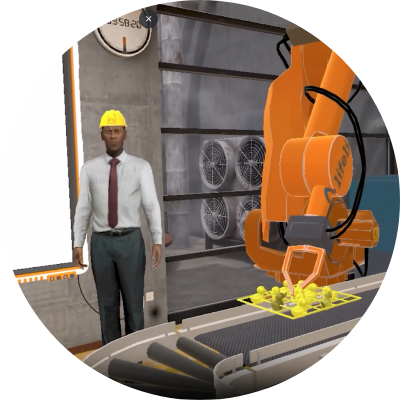 Loading...
Loading...
Initial language selection is based on your web browser preferences.

12MB
Free
Gain practical, visual experience in vocational training through this immersive simulation set in a manufacturing context. Deepen students' understanding of math topics such as fractions and percentages, while learning how these skills enhance production processes. Guided by a virtual QA assistant, students assume the role of a trainee technician on the factory floor. They complete a series of practical simulations - from inspecting product quality to interpreting machine efficiency - that directly link mathematical thinking to improved workplace performance. **Key features:** - Aligned to the ACT WorkKeys Applied Math curriculum (Levels 3 & 5) - Applies core maths concepts to real-world workplace scenarios - Features guided narration, virtual instructions and dynamic model interactions for every task ## Course Content: This course is one module, split into two lessons: **Module 1: Math in the Workplace** - Lesson 1: Fractions - Lesson 2: Percentages ## Duration & Guidance: Each lesson is approximately 10-15 minutes in duration, but times may vary depending on the user. Lessons can be completed across multiple sessions, as user progress will be saved. We recommend that this experience is best undertaken standing, although a seated experience is possible. ## Module 1: Math in the Workplace{.objective .objective1} **Lesson 1: Fractions** Join a quality assurance assistant in a manufacturing training center. Learn how to read and apply fractions during product checks and understand how they help support decision-making. ## Learning Objectives: - Define the denominator{.info} - Define the numerator{.info} - Explore how fractions can be applied in the workplace{.info} **Lesson 2: Percentages** Return to the factory floor to explore how percentages link to fractions and decimals. Evaluate the efficiency of the factory machines by turning fractions into percentages. ## Learning Objectives: - Explore the relationship between fractions, decimals and percentages{.info} - Evaluate the efficiency of the machines{.info} # TEACHING FRAMEWORK{.objective .objective} # Before the Experience **KWL Chart** Activate prior knowledge and prepare students for what they will see in VR simulation. Students will fill in the K (What I Know) and W (What I Want to Know) sections, while the remaining section will be completed post-experience. - Identify three things that you already know or think you know about the industry, technology, tools used and/or careers.{.task} - Write two questions about what you want answered or are curious about.{.task} # During the Experience **Tech Lab Journal** To support engagement and learning during each VR session, ask students to maintain a Tech Lab Journal. This journal can be a small notebook, a stapled packet, a digital document or use the worksheet provided (see exemplar for further guidance). The Vocational Pathways Worksheet Exemplar draws on the Welding and Intro to Construction simulations as detailed case studies. While these examples focus on specific experiences, the model student responses are representative of reflections, observations, vocabulary and presentations expected across all of the Vocational Pathways content. After completing each VR session, students should take a few minutes to reflect and add to their journal, noting the date and which lesson they completed. Other suggested journal entries may include: - Key Vocabulary – Identify new terms and/or technical language that was introduced, along with definitions for each. - Sketches or Diagrams – Create simple sketches of tools, systems, processes and/or machines students interacted with, along with labels for the whole and its parts. - Notice and Wonder – Take note of interesting moments or surprising results students noticed, as well as questions they are curious about. These should be written as “I noticed...” and “I wonder ...” statements. # After the Experience **KWL Chart** To follow up, ask students to complete the L (What I Learned) section, reflecting on what they learned during the session. - Identify at least three things that you learned about the industry, technology, concepts or career.{.task} # Extended Learning **Job Quest: Explore an Entry-Level Career Role** Students are then encouraged to continue their learning by researching what an entry-level position in this career field looks like. This exploration makes learning more personal and purposeful, helping students consider future career opportunities. Even if they decide this career is not a good fit, the process builds career awareness, critical thinking, and allows the student to take ownership of their learning. Ask students to research the following: - Job Description - Tools and Skills Needed - Education and/or Training Needed - Salary and Job Outlook - Work Environment Ask students to create a visual summary of their research. Consider giving them a choice to create a slide presentation, one-pager, infographic, short video, or use another appropriate presentation method. # Reflection Ask students to write a reflection. Based on their VR experience and research, would they consider this career? Why or why not? # How To View Student Analytics 1. Log in to the Corinth app 1. Results can be viewed based on the name the student entered For full setup instructions, including video walkthroughs and support documents, please visit our support pages [ClassVR Support](https://www.classvr.com/)